12th Economics Chapter 3B (Elasticity of Demand) Maharashtra Board – Free Solution
Table of Contents
12th Economics Chapter 3B – Elasticity of Demand
12th Economics Chapter 3B – Elasticity of Demand: The law of demand does not explain the extent of a change in demand due to a change in the price. Thus, the law of demand fails to explain the quantitative relationship between price and quantity demanded. Therefore, Prof. Alfred Marshall explained the concept of elasticity of demand.
This chapter will explain the elasticity of demand, its types, factors, importance, etc. To understand these topics, read Elasticity of Demand solutions prepared by our experts.
We covered extra questions in each chapter.
Chapter 3B – Elasticity of Demand
Q. 1. Complete the following statements by choosing the correct alternatives
1) Price elasticity of demand on a linear demand curve at the X-axis is _____.
a) zero
b) one
c) infinity
d) less than one
2) Price elasticity of demand on a linear demand curve at the Y-axis is equal to _____.
a) zero
b) one
c) infinity
d) greater than one
3) Demand curve is parallel to X-axis, in the case of _____.
a) perfectly elastic demand
b) perfectly inelastic demand
c) relatively elastic demand
d) relatively inelastic demand
4) When the percentage change in quantity demanded is more than the percentage change in price, the demand curve is _____.
a) flatter
b) steeper
c) rectangular
d) horizontal
5) Ed = 0 in case of _____.
a) luxuries
b) normal goods
c) necessities
d) comforts
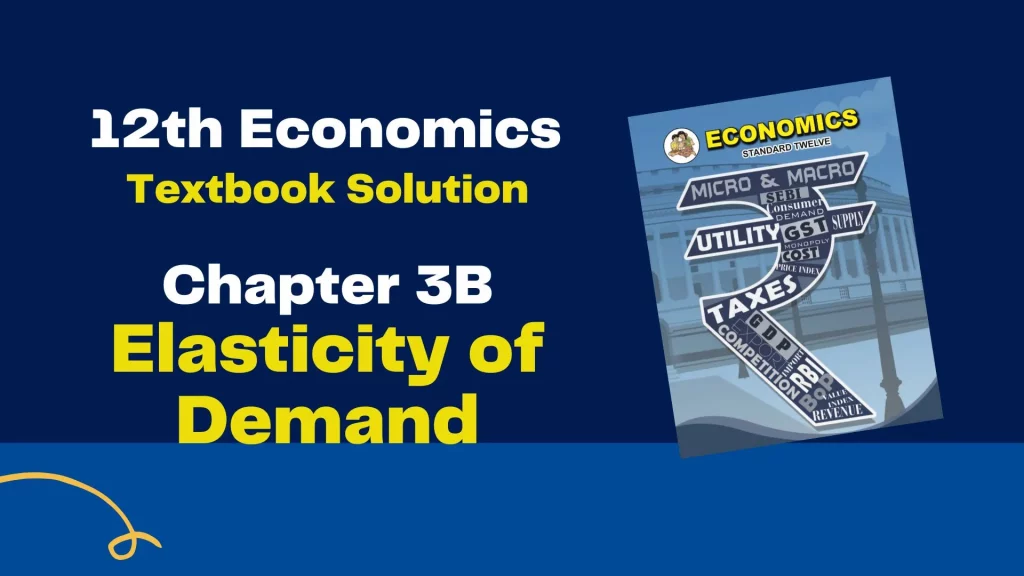
Q. 2. Give economic terms
1) Degree of responsiveness of quantity demanded to change in income only. Income Elasticity of Demand.
2) Degree of responsiveness of a change in quantity demanded of one commodity due to change in the price of another commodity. Cross Elasticity of Demand.
3) Degree of responsiveness of a change of quantity demanded of a good to a change in its price.
Price Elasticity of Demand.
4) Elasticity resulting from infinite change in quantity demanded. Perfect Elasticity
5) Elasticity resulting from a proportionate change in quantity demanded due to a proportionate change in price. Unitary Elasticity
Q. 3. Complete the correlation
1) Perfectly elastic demand : Ed = ∞ : : Perfectly inelastic demand : Ed = 0
2) Rectangular hyperbola : Unitary elastic demand : : Steeper demand curve : Relatively inelastic demand.
3) Straight line demand curve : Linear demand curve : : Curved line demad curve : non linear demand curve.
4) Pen and ink : Complementary Goods : : Tea and Coffee : Substitutes.
5) Ratio method : Ed = %Change in Quantity / %Change in Price : : Geometrical Method : Ed = Lower segment / Upper segment
Q.4. Assertion and Reasoning type questions
1) Assertion (A): Elasticity of demand explains that one variable is influenced by another variable.
Reasoning (R): The concept of elasticity of demand indicates the effect of price and changes in other factors on demand.
Options :
1) (A) is True, but (R) is False
2) (A) is False, but (R) is True
3) Both (A) and (R) are True and (R) is the correct explanation of (A)
4) Both (A) and (R) are True and (R) is not the correct explanation of (A)
2) Assertion (A): A change in quantity demanded of one commodity due to a change in the price of other commodity is cross elasticity.
Reasoning (R): Changes in consumers income leads to a change in the quantity demanded.
Options :
1) (A) is True, but (R) is False
2) (A) is False, but (R) is True
3) Both (A) and (R) are True and (R) is the correct explanation of (A)
4) Both (A) and (R) are True and (R) is not the correct explanation of (A)
3) Assertion (A): Degree of price elasticity is less than one in case of relatively inelastic demand.
Reasoning (R): Change in demand is less then the change in price.
Options :
1) (A) is True, but (R) is False
2) (A) is False, but (R) is True
3) Both (A) and (R) are True and (R) is the correct explanation of (A)
4) Both (A) and (R) are True and (R) is not the correct explanation of (A)
Solution of other subjects
Solution of all Chapters of Economics
1 – 2 – 3A – 3B – 4 – 5 – 6 – 7 – 8 – 9 – 10
Q.5. Distinguish between
1) Relatively elastic demand and Relatively inelastic demand.
| Points | Relatively elastic demand | Unitary elastic demand |
| 1)Meaning | When a percentage change in price leads to more than proportionate change in quantity demanded, the demand is said to be relatively elastic. | When a percentage change in price leads to less than proportionate change in the quantity demanded, demand is said to be relatively inelastic. |
| 2) Numerical Value | The numerical value of elasticity of demand is greater than one. | The numerical value of elasticity of demand is lesser than one. |
2) Perfectly elastic demand and Perfectly inelastic demand.
| Points | Perfectly elastic demand. | Perfectly inelastic demand. |
| 1)Meaning | When a slight or zero change in the price brings about an infinite change in the quantity demanded of that commodity, it is called perfectly elastic demand. | When a percentage change in price has no effect on the quantity demanded of a commodity it is called perfectly inelastic demand. |
| 2) Numerical Value | The numerical value of elasticity of demand is Infinite. | The numerical value of elasticity of demand is zero. |
Q.6. Answer the following questions
1) Explain the factors influencing elasticity of demand.
Answer: Elasticity of demand depends upon several factors which are discussed below:
1) Nature of commodity:
By nature, we can classify commodities as necessities, comforts, and luxury goods. Demand for necessities like food grains, medicines, textbooks, etc. is relatively inelastic, while demand for comforts and luxury goods like cars, perfumes, furniture, etc., is relatively elastic.
2) Availability of substitutes:
Demand for a commodity will be more elastic, if its close substitutes are available in the market. For example, lemon juice, sugarcane juice etc. But commodities having no close substitutes like salt the demand will be inelastic.
3) Number of uses:
Single use goods have a less elastic demand. Multi-use goods have more elastic demand, For example, coal, electricity etc.
4) Habits:
Habits make demand for certain goods relatively inelastic. For example, addicted goods, drugs, etc.
5) Durability:
The demand for durable goods is relatively elastic. For example, furniture, washing machine etc. Demand for perishable goods is inelastic. For example, milk, vegetables etc.
6) Complementary goods:
The demand for a commodity that is used in conjunction with other commodities to satisfy a single want is relatively inelastic. For example, a fall in the price of mobile handsets may lead to a rise in the demand for sim cards.
7) Income of the consumer:
Demand for goods is usually inelastic if the consumer has high income. The demand pattern of a very rich and an extremely poor person is rarely affected by significant changes in the
price.
8) Urgency of needs:
Goods that are urgently needed will have relatively inelastic demand. For example, medicines. Less urgent luxury goods have relatively elastic demand.
9) Time period:
The elasticity of demand is always related to period of time. It varies with the length of time period. Generally speaking, longer the duration of period greater will be the elasticity of demand and vice-versa. This is because a consumer can change their consumption habits in the long run in favour of cheaper substitutes of the commodities.
10) Proportion of expenditure:
If the proportion of expenditure in a person’s income is small, then demand for the product is relatively inelastic. For example, news papers. If the proportion of expenditure is large, then demand for the product is relatively elastic.
Note: If the question is asked for 8 marks write 9 to 10 points and if question is asked for 4 marks write 4 to 6 points ( Use this suggestion for all questions and chapters)
2) Explain the total outlay method of measuring elasticity of demand? (Total expenditure method)
Answer: This method was developed by Prof. Marshall. In this method, total amount of expenditure before
and after the price change is compared.this method is also known as Total expenditure method.
Here the total expenditure refers to the product of price and quantity demanded.
Total expenditure = Price × Quantity demanded
In this connection, Marshall has given the following propositions:
A) Relatively elastic demand (Ed >1): When with a given change in the price of a commodity total outlay increases, elasticity of demand is greater than one.
B) Unitary elastic demand (Ed = 1): When price falls or rises, total outlay does not change or remains constant, elasticity of demand is equal to one.
C) Relatively inelastic demand (Ed <1): When with a given change in price of a commodity total outlay decreases, elasticity of demand is less than one.
This can be explained with the help of the following example.

In the above table, in example ‘A’ original price is Rs 10 per unit and quantity demanded is 6 units. Therefore, total expenditure incurred is Rs 60. When price rises to Rs 20 quantity demanded falls to 5 units, the total expenditure incurred is Rs 100. In this case, total outlay is greater than original expenditure. Hence, in this example elasticity of demand is greater than one. (Ed >1) that is relatively elastic demand.
In example ‘B’, original price is Rs 30 per unit and quantity demanded is 4 units. Therefore total expenditure is Rs 120. When price rises to Rs 40 quantity demanded falls to ‘3’ units. Total expenditure incurred is Rs120. In this case total outlay is same (equal) to original expenditure. Hence, in this example, elasticity of demand is equal to one (Ed = 1) that is unitary elastic demand.
In example ‘C’, original price is Rs 50 per unit and quantity demanded is 2 units. Therefore total expenditure is Rs 100. When price rises to Rs 60, quantity demand falls to 1 unit and total expenditure incurred is Rs 60. In this case total outlay is less than original expenditure. Hence, elasticity of demand is less than one (Ed <1) that is relatively inelastic demand.
3) Explain importance of elasticity of demand.
Answer: The concept of elasticity of demand is of great importance to producers, farmers, workers and the Government. Lord Keynes considered this concept to be the most important contribution of Alfred Marshall. The significance of the concept becomes clear from the following applications
1) Importance to a Producer:
Every producer has to decide the price of his product at which he has to sell it. For this purpose, elasticity of demand becomes important. If the demand for a product is relatively inelastic, he will fix up a higher price and vice-versa. The concept of elasticity of demand is also useful to a monopolist to practice price discrimination.
2) Importance to Government:
Taxation policy of the Government is based on the concept of elasticity of demand. Those commodities whose demand is relatively inelastic will be taxed more because it will not affect their demand much and vice-versa.
3) Important in Factor Pricing:
The concept of elasticity of demand is useful in determination of factor prices. The factor of production for which demand is relatively inelastic can command a higher price as compared to those having elastic demand. For example, workers can ask for higher wages, if the demand for the product produced by them is relatively inelastic.
4) Importance in Foreign Trade:
The concept of elasticity of demand is useful to determine terms and conditions in foreign trade. The countries exporting commodities for which demand is relatively inelastic can raise their prices. For example, OPEC have increased the price of oil several times. The concept is also useful in formulating export and import policy of a country.
5) Public Utilities:
In case of public utilities like railways which have an inelastic demand, the Government can either subsidize or nationalise them to avoid consumer exploitation.
6) Proportion of expenditure:
If the proportion of expenditure in a person’s income is small, then demand for the product is relatively inelastic. For example, newspapers. If the proportion of expenditure is large, then demand for the product is relatively elastic.
Solution of other subjects
Solution of all Chapters of Economics
1 – 2 – 3A – 3B – 4 – 5 – 6 – 7 – 8 – 9 – 10
Q.7. Observe the following figure and answer the questions
1) Identify and define the degrees of elasticity of demand from the following demand curves.
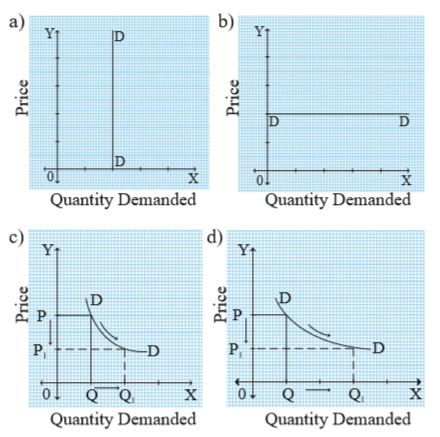
a) Perfectly Inelastic Demand: When a percentage change in price has no effect on the quantity demanded of a commodity it is called perfectly inelastic demand.
b) Perfectly Elastic Demand: When a slight or zero change in the price brings about an infinite change in the quantity demanded of that commodity, it is called perfectly elastic demand.
c) Unitary elastic demand: When a percentage change in price leads to a proportionate change in quantity demanded then demand is said to be unitary elastic.
d) Relatively elastic demand: When a percentage change in price leads to more than proportionate change in quantity demanded, the demand is said to be relatively elastic.
2) In the following diagram AE is the linear demand curve of a commodity. On the basis of the given diagram state whether the following statements are True or False. Give reasons to your answer.
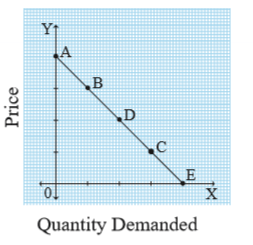
1) Demand at point ‘C’ is relatively elastic demand.
Answer: False
Reason: On the demand curve AE, the distance of CE is less than that of CA. Thus, point ‘C’ is close to X-axis. therefore, the demand at point ‘C’ is realtively inelastic.
2) Demand at point ‘B’ is unitary elastic demand.
Answer: False
Reason: On the demand curve AE, the distance of BE is greater than that of BA. Thus, point ‘B’ is close to Y-axis. therefore, the demand at point ‘B’ is realtively elastic.
3) Demand at point ‘D’ is perfectly inelastic demand.
Answer: False
Reason: On the demand curve AE, the distance of DE is equal to that of DA. Thus, point ‘D’ is at same distance from both axis. therefore, the demand at point ‘D’ is unitary elastic.
4) Demand at point ‘A’ is perfectly elastic demand.
Answer: True
Reason: On the demand curve AE, at point ‘A’ the lower segment of the demand curve is AE and there is no upper segment. therefore, the demand at point ‘A’ is Perfectly elastic.
Extra Questions
Distinguish Between:
1) Income Elasticity of Demand and Cross Elasticity of Demand.
| Income Elasticity of Demand | Cross Elasticity of Demand |
| It refers to the degree of responsiveness of a change in quantity demanded to a change in the income only, other factors including price remain unchanged. | It refers to a change in quantity demanded of one commodity due to a change in the price of other commodities.(Complementary goods or substitutes) |
| Ey = % Change in quantity demanded Q / % Change in income of a consumer Y | Ec = Percentage change in Qty. demanded of A/Percentage change in Price of B (A = Original commodity, B = Other commodity) |
Answer the following questions:
1) Explain the types of Elasticity of Demand.
2) What are the types of price elasticity of demand?
Answer:
Price elasticity: According to Prof. Alfred Marshall, price elasticity of demand is a ratio of proportionate change in the quantity demanded of a commodity to a given proportionate change in its price only.
Ed = Percentage change in Quantity Demanded/Percentage change in Price
Symbolically,
Ed = %∆Q / %∆P ,
Ed = ∆Q/Q ÷ ∆P/P
Ed = ∆Q/Q × P/∆P
Where,
Q = Original quantity demanded
∆Q = Difference between the new quantity and original quantity demanded
P = Original price
∆P = Difference between new price and original price
Following are the types of Price Elasticity of Demand:
1) Perfectly Elastic Demand (Ed = ∞) :
When a slight or zero change in the price brings about an infinite change in the quantity demanded of that commodity, it is called perfectly elastic demand. It is only a theoretical concept. For example, a 10% fall in price may lead to an infinite rise in demand.
Ed = Percentage change in Quantity Demanded / Percentage change in Price = ∞
Ed = ∞
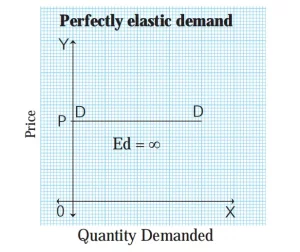
In the above figure, the demand curve DD is a horizontal line parallel to the X-axis indicating perfectly elastic demand.
2) Perfectly inelastic demand (Ed = 0) :
When a percentage change in price has no effect on the quantity demanded of a commodity it is called perfectly inelastic demand. For example, a 20% fall in price will have no effect on the quantity demanded.
Ed = %∆Q / %∆P
Ed = 0/20 = 0
Ed = 0
In practice, such a situation rarely occurs. For example, demand for salt, and milk.
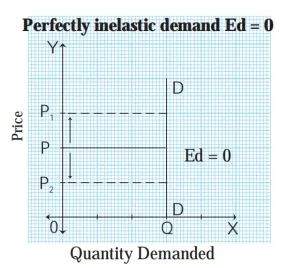
In the above figure, when price rises from OP to OP1 or when the price falls from OP to OP2, demand remains unchanged at OQ. Therefore, the demand curve is a vertical straight line parallel to the Y axis, indicating perfectly inelastic demand.
3) Unitary elastic demand (Ed = 1) :
When a percentage change in price leads to a proportionate change in quantity demanded then demand is said to be unitary elastic. For example, 50% fall in price of a commodity leads to 50% rise in quantity demanded.
Ed = %∆Q / %∆P
Ed = 50/50 = 1
∴ Ed = 1
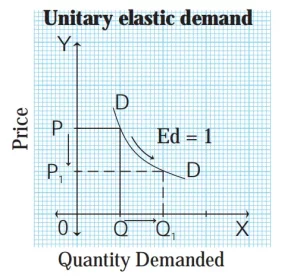
In the above figure, when price falls from OP to OP1 (50%), demand rises from OQ to OQ1 (50%). Therefore, the slope of the demand curve is a ‘rectangular hyperbola’.
4) Relatively elastic demand (Ed >1) :
When a percentage change in price leads to more than proportionate change in quantity demanded, the demand is said to be relatively elastic. For example, 50% fall in price leads to 100% rise in quantity demanded.
Ed = %Q / %P
Ed = 100/50
∴Ed = 2
Ed > 1
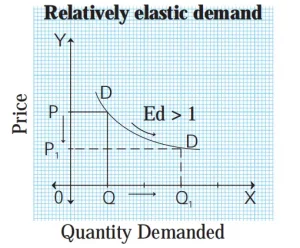
In the above figure, when price falls from OP to OP1 (50%), demand rises from OQ to OQ1 (100%). Therefore, the demand curve has a flatter slope.
5) Relatively inelastic demand (Ed < 1) :
When a percentage change in price leads to less than proportionate change in the quantity demanded, demand is said to be relatively inelastic. For example, 50% fall in price leads to 25% rise in quantity demanded.
Ed = %∆Q / %∆P = 25/50 = 0.5
Ed = 0.5
∴Ed < 1

In the above figure, when price falls from OP to OP1 (50%), demand rises from OQ to OQ1 (25%). Therefore, the demand curve has a steeper slope.
3) Explain the Ratio or Percentage method of measuring elasticity of demand.
Ratio or Percentage method:
The ratio method was developed by Prof. Marshall. According to this method, the elasticity of demand is measured by dividing the percentage change in demand by the percentage change in price. The percentage method is also known as the Arithmetic method. Price elasticity is measured as :
Ed = Percentage change in Quantity demanded / Percentage change in Price
Symbolically:
Ed=△Q/Q ÷△P/P
=△Q/Q × P/△P
△Q = Difference between the new quantity and original quantity demanded.
△P = Difference between the new price and original price
Q = Original quantity demanded
P = Original price
Numerical example:
| Price (Rs) | Qty. Demanded (in Kg) | Formula |
| 20 | 10 | Ed=△Q/Q × P/△P |
| 25 | 09 |
Original Price, P = 20, New price P = 25
△P = 5 (Difference between new and original price)
Original Quantity Demanded, Q = 10, New demand = 9
△Q = 1 (Difference between new and original quantity demanded)
Ed = △Q/Q × P/△P
Ed = 1/10 × 20/5
Ed = 0.4
Ed < 1
It means the elasticity of demand is relatively inelastic.
4) Explain the Point or Geometric method of measuring elasticity of demand.
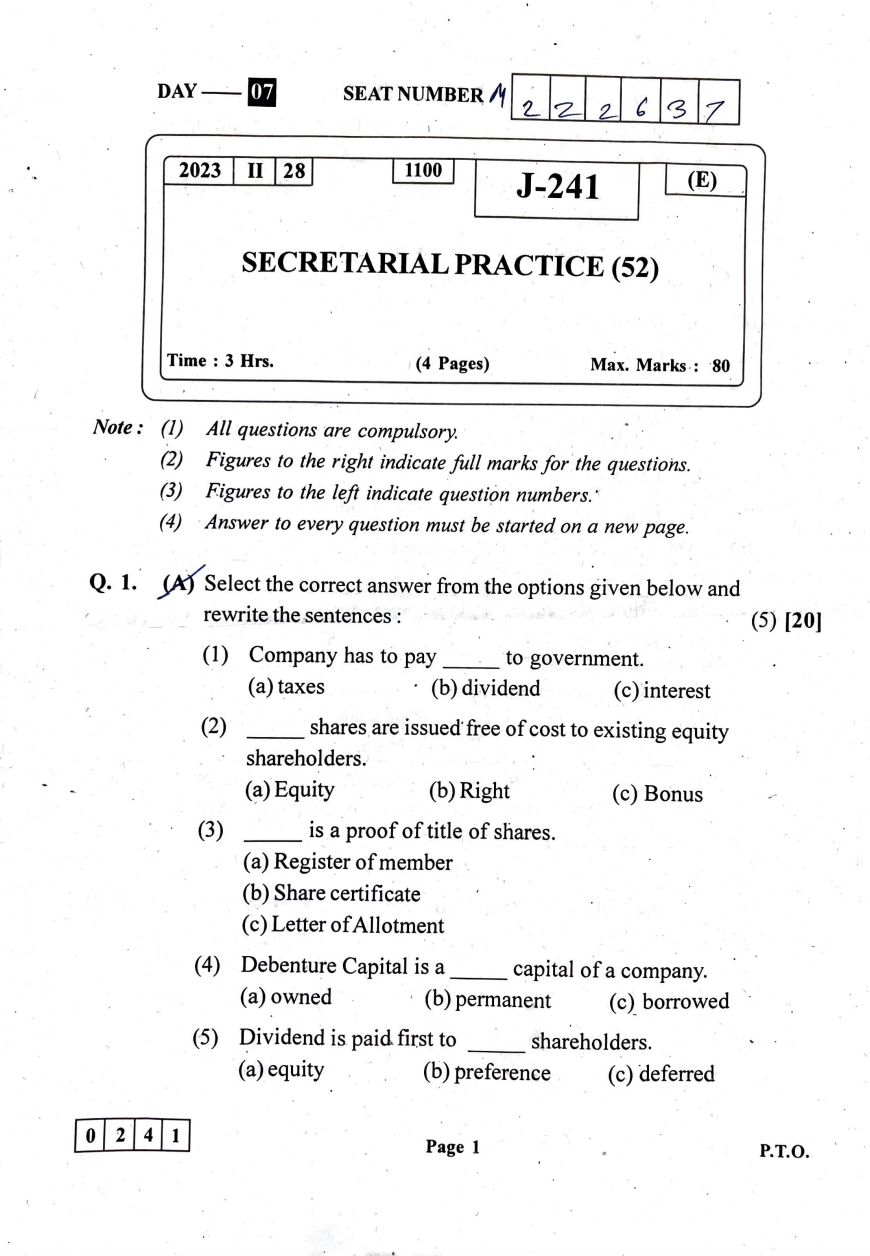


Thank you very much.
keep learning and share our website with your friends.
Thank you